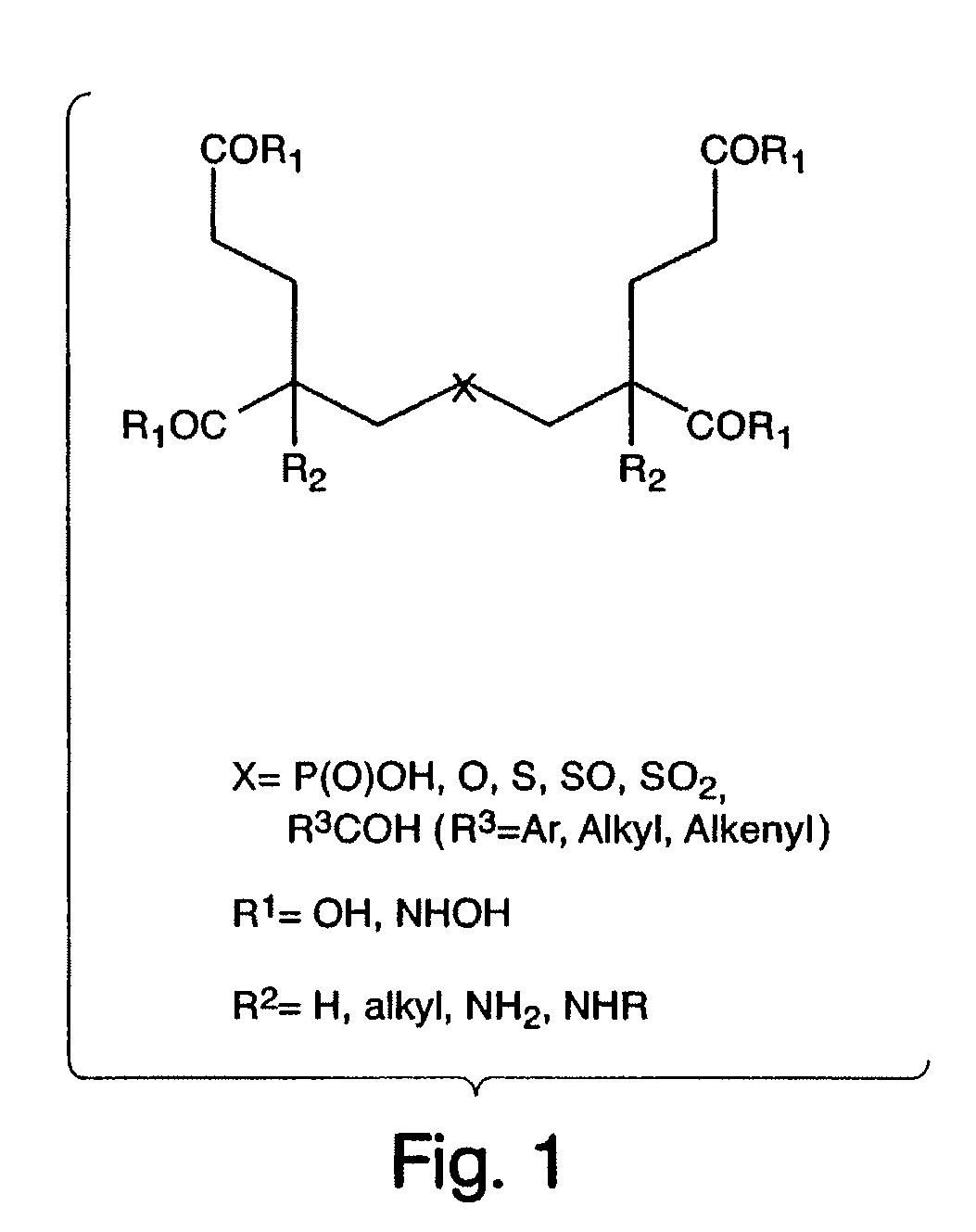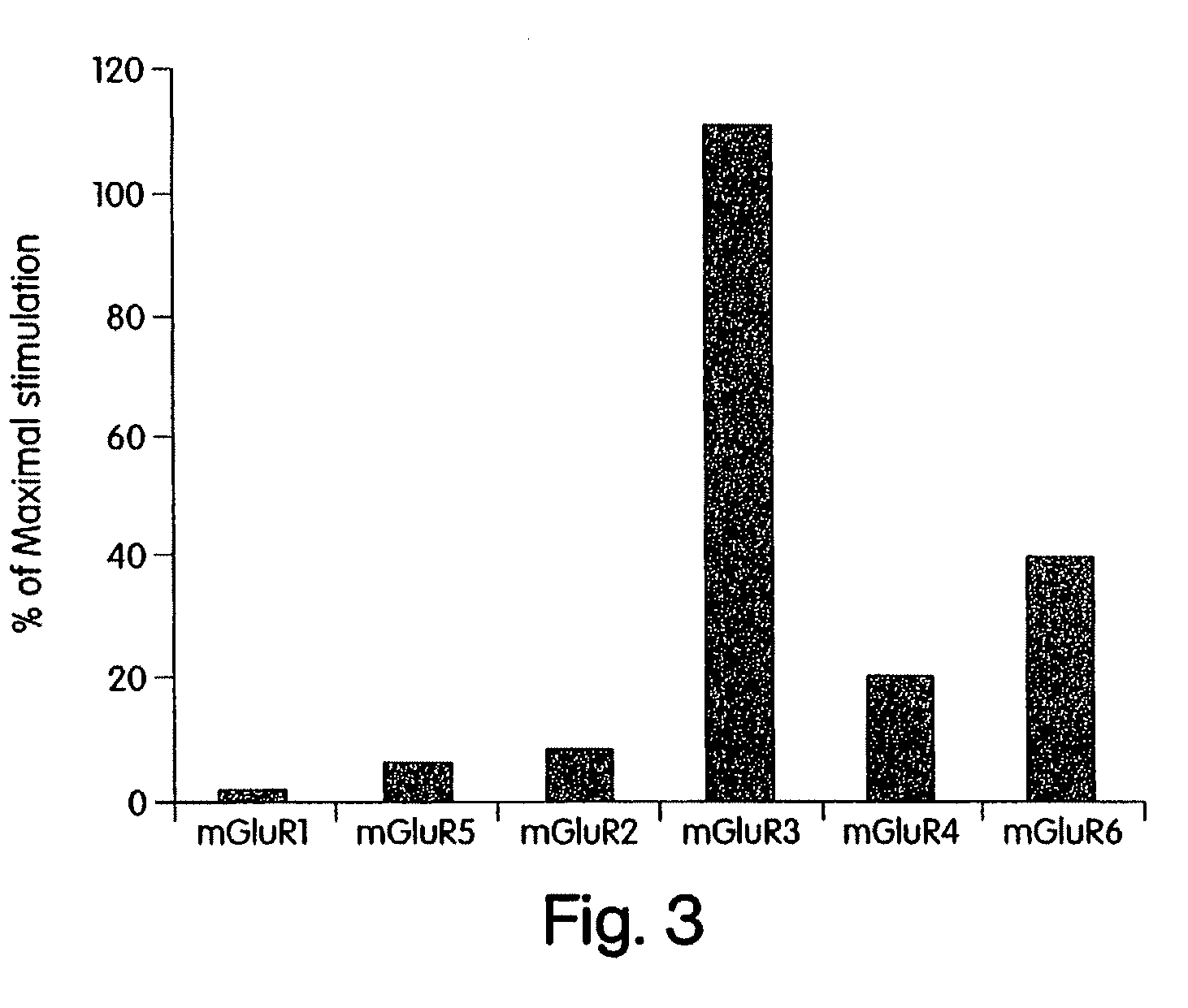Ligands for metabotropic glutamate receptors and inhibitors of NAALADase
a technology of naaladase inhibitors and metabotropic glutamate receptors, which is applied in the direction of drug compositions, phosphorous compound active ingredients, peptide/protein ingredients, etc., can solve the problems of poor reparative ability of central nervous tissue, to a lesser extent peripheral nervous tissue, and the specific mglur receptors mediated these cellular functions are largely undefined,
- Summary
- Abstract
- Description
- Claims
- Application Information
AI Technical Summary
Benefits of technology
Problems solved by technology
Method used
Image
Examples
example 1
[0268]
[0269]Anhydrous sodium hypophosphite (prepared from sodium hypophosphite monohydrate by azeotropic distillation with toluene in vacuo at 50° C.) (940 mg, 10.8 mmol) was suspended in 60 mL of dry CH2Cl2 and cooled to 0° C., then triethylamine (2.50 mL, 18.9 mmol) and chlorotrimethylsilane (2.32 mL, 18.4 mmol) were added. After 5 min, compound 1 (500 mg, 1.54 mmol) in 5 mL of dry CH2Cl2 was added. The mixture was stirred at rt for 24 h before 1 N HCl (20 mL) was added. The reaction mixture was extracted with CH2Cl2 (3×40 mL), and the combined organic phases were dried (MgSO4). After concentration, the residue was dissolved in 6 mL of dry CH2Cl2 and 0.6 mL of pyridine and cooled to 0° C., then trimethylacetyl chloride (0.3 mL, 2.25 mmol) was added followed by benzyl alcohol (0.21 mL, 1.8 mmol). The mixture was stirred at 0° C. to rt for 2 h, then diluted with ether. The organic layer was washed with 1 N HCl (10 mL), H2O (10 mL), and brine (10 mL), dried (MgSO4), and concentrated....
example 2
[0270]
[0271]To a solution of 2 (210 mg, 0.44 mmol) in 5 mL of dry THF was added sodium hydride (15 mg, 60% dispersion in oil, 0.44 mmol) followed by compound 1 (140 mg, 0.44 mmol) at 0° C., and the mixture was stirred at rt for 2 h before 1 N HCl was added. The reaction mixture was extracted with CH2Cl2 (3×20 mL). The combined organic layers were dried (MgSO4) and concentrated. Flash chromatography over silica gel with ethyl acetate-hexanes (1:1) as eluent gave compound 3 (45 mg, 13%) as a colorless oil: 1H NMR (CDCl3, 300 MHz) δ 7.34-7.27 (m, 25H), 5.06-4.89 (m, 10H), 2.83 (m, 2H), 2.33-2.14 (m, 6H), 2.00-1.60 (m, 6H); 31P NMR (CDCl3, 121 MHz) δ−28.51, −28.90, −29.34; 13C NMR (CDCl3, 75 MHz) δ 173.80, 172.19, 136.27, 135.78, 135.50, 128.60, 128.56, 128.42, 128.33, 128.28, 128.24, 128.19, 128.14, 66.91, 66.87, 66.80, 66.37, 66.10, 66.02, 38.65, 38.51, 31.71, 30.32, 31.24, 30.67, 30.57, 30.04, 28.85, 28.69.
example 3
[0272]
[0273]To a solution of 3 (42 mg, 0.52 mmol) in tert-butanol was added 30 mg of 20% Pd(OH)2 / C (Aldrich, ≦50% H2O), and the mixture was hydrogenated under 70 psi of H2 for 24 h. The catalyst was removed by filtration through celite, and the filtrate was concentrated. The residue was dissolved in 5 mL of water and lyophilized to afford 17 mg (92%) of FN-6 as a white solid: 1H NMR (D2O, 300 MHz) δ 2.77 (m, 2H), 2.44 (t, J=7.3 Hz, 4H), 2.20 (dt, J=13.2, 11.3 Hz, 2H), 2.00-1.82 (m, 6H); 31P NMR (D2O, 121 MHz) δ−33.12; 13C NMR (D2O, 75 MHz) δ 179.69, 179.61, 178.61, 39.89, 32.70, 32.28, 31.49, 29.68, 29.58, 29.52, 29.42.
PUM
 Login to View More
Login to View More Abstract
Description
Claims
Application Information
 Login to View More
Login to View More - R&D
- Intellectual Property
- Life Sciences
- Materials
- Tech Scout
- Unparalleled Data Quality
- Higher Quality Content
- 60% Fewer Hallucinations
Browse by: Latest US Patents, China's latest patents, Technical Efficacy Thesaurus, Application Domain, Technology Topic, Popular Technical Reports.
© 2025 PatSnap. All rights reserved.Legal|Privacy policy|Modern Slavery Act Transparency Statement|Sitemap|About US| Contact US: help@patsnap.com



